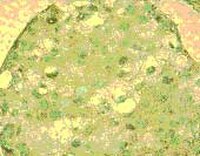PC522 Sigma-AldrichAnti-Adenine Nucleotide Translocase-1 (Ab-1) (2-11) Rabbit pAb
Anti-Adenine Nucleotide Translocase-1 (Ab-1) (2-11), rabbit polyclonal, recognizes ~35 kDa ANT-1 in doxorubicin-treated MCF-7 cells. It is validated for WB, immunofluorescence, and paraffin sections.
More>> Anti-Adenine Nucleotide Translocase-1 (Ab-1) (2-11), rabbit polyclonal, recognizes ~35 kDa ANT-1 in doxorubicin-treated MCF-7 cells. It is validated for WB, immunofluorescence, and paraffin sections. Less<<Synonyms: Anti-ANT-1
Recommended Products
Přehled
| Replacement Information |
|---|
Tabulka spec. kláve
| Species Reactivity | Host | Antibody Type |
|---|---|---|
| H | Rb | Polyclonal Antibody |
| Description | |
|---|---|
| Overview | Recognizes the ~35 kDa ANT-1 protein in doxorubicin-treated MCF-7 cells or breast carcinoma tissue.
|
| Catalogue Number | PC522 |
| Brand Family | Calbiochem® |
| Synonyms | Anti-ANT-1 |
| Application Data |  Detection of human ANT-1 by staining paraffin sections. Sample: Breast carcinoma. Primary antibody: Anti-Adenine Nucleotide Translocase-1 (Ab-1) (2-11) Rabbit pAb (Cat. No. PC522) (1 µg/ml). Detection: DAB with methyl green counterstain. |
| Product Information | |
|---|---|
| Form | Liquid |
| Formulation | In 50 mM sodium phosphate buffer, 50% glycerol. |
| Positive control | doxorubicin-treated MCF7 cells, or breast carcinoma tissue |
| Preservative | None |
| Physicochemical Information |
|---|
| Dimensions |
|---|
| Materials Information |
|---|
| Toxicological Information |
|---|
| Safety Information according to GHS |
|---|
| Safety Information |
|---|
| Product Usage Statements |
|---|
| Packaging Information |
|---|
| Transport Information |
|---|
| Supplemental Information |
|---|
| Specifications |
|---|
| Global Trade Item Number | |
|---|---|
| Katalogové číslo | GTIN |
| PC522 | 0 |
Documentation
Anti-Adenine Nucleotide Translocase-1 (Ab-1) (2-11) Rabbit pAb MSDS
| Title |
|---|
Anti-Adenine Nucleotide Translocase-1 (Ab-1) (2-11) Rabbit pAb Certificates of Analysis
| Title | Lot Number |
|---|---|
| PC522 |
References
| Přehled odkazů |
|---|
| Bauer, M.K.A., et al. 1999. J. Cell Biol. 147, 1493. Marzo, I, et al. 1998. Science 281, 2027. Marzo, I, et al. 1998. J. Exp. Med. 187, 1261. Zoratti, M. and Szabo, I. 1995. Biochim. Biophys. Acta 1231, 139. Klingenberg, M. 1993. J. Bioenerg. Biomembr. 25, 447. Riccio, P., et al. 1975. FEBS Lett. 56, 133. |







